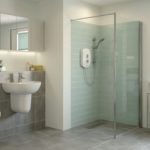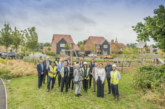English Housing Survey statistics have shown that the largest percentage of families with disabled children live in social housing. In fact, 5.6% of housing association properties accommodate a disabled child or children, compared with only 2.1% in the privately-owned housing sector. Stuart Reynolds, Head of Product and Marketing at AKW, shows how social housing providers can build versatility into both the bathroom and kitchen for these children and young people.
(Header image: The iTherm thermostatic shower from AKW features LED Temperature and Flow Indicators)
More disabled children are surviving infancy and children under 16 are the fastest growing demographic of disabled people. In the UK, there are a total of 800,000 disabled children under the age of 16 (this equates to one child in 20) and 99.1% of disabled children live at home and are supported by their families. As well as families with disabled children making up 5% of all households in the social sector, a quarter of these families will have more than one disabled child. This is obviously creating increasing pressure on social housing and raises the question as to whether existing stock is fit for purpose for such families.

Building inclusive living into housing stock
In its recent report on housing for the disabled, the Equality and Human Rights Commission says: “Our research with disabled people and parents of disabled children found that their housing aspirations were often no different from those that might be expected of non-disabled people. In general, those interviewed valued safety and security, good transport links and friendly neighbours. However, other preferences emerged that related specifically to the participants’ disabilities: for example, accessible kitchens and bathrooms were particularly sought after.”
So, for social landlords looking to build inclusivity into their housing stock, both the bathroom and the kitchen are the main areas to focus on. Here are key ways to bring inclusivity into housing stock, cost-effectively:
Cost-effective wet rooms — Traditional shower cubicles are not an option for wheelchair users and present a high risk of trip accidents because of the raised threshold for less mobile young residents. A safer alternative is a level-access wet room that users can wheel in and out of with ease. These also make the best use of the space available in even the smallest of bathrooms and give the room a contemporary and stylish appearance. As well as being easy to install, with the use of high quality wet room formers, this solution can be designed to withstand heavy-duty use and high loads, so that wheelchairs can be used safely in them without fear of damage.
To maximise cost-efficiencies and minimise installation times, AKW offers a system that features a built in wet room former and adapter to make it possible to rapidly – usually in less than half a day – and simply transform a bathroom with a conventional bathtub to a wet room. This concept of a flexible room means the bath can be removed or put back in place whenever needed, according to the requirements of each tenant, whether they be young or old, that enters the home.

Creating space in the bathroom — The aim is to make manoeuvring around the bathroom straightforward and safe for those in wheelchairs, or who use mobility aids. If it is possible, thought needs to be given to the placement of toilets, soil pipes and the basin. However, if these items are already in-situ and they are difficult to move, then compact or wall-mounted basins or raised height toilets are also available.
Advanced showers — Alongside thermostatically controlled showers, there is now a Bluetooth enabled ones available, for example AKW’s SmartCare Plus shower, that can be controlled via tactile buttons on the shower unit, or using a wireless remote control or Smartphone app. Settings can be personalised and saved and alarms programmed to turn the shower on at specific times. A delayed mode has also been incorporated to enable parents to transfer disabled children out of the shower before it can be reactivated.
Improved access
As well as promoting independence in the bathroom, there is a range of options available to allow young people greater access to the kitchen area as well:
Promoting independence in the kitchen — Ensuring disabled young people can independently and safely use the kitchen can be a real challenge. An accessible kitchen that works well for the whole family takes into account things such as wheelchair turning circles and the young person’s strength, reach, mobility and grip challenges. AKW’s kitchen design experts often organise joint visits with installers and occupational therapists to the home, to build on the information contained in the referral. This ensures that every aspect of the young person’s mobility issues have been understood and taken into account.
Building safety into the design — Pull out or rise and fall kitchen work surfaces, drop down units and rotating corner unit shelves are all available to help create a kitchen that works for the whole family. For those in wheelchairs AKW also produces recessed or rebated plinths to allow the wheelchair footrest to rotate under each unit, which is especially useful in narrower kitchens where the turning circle of the wheelchair is greater than the existing space available.
Bathrooms and kitchens that help promote independence and improve safety for disabled children, young people and their families are life changing, yet they need not cost the earth.










